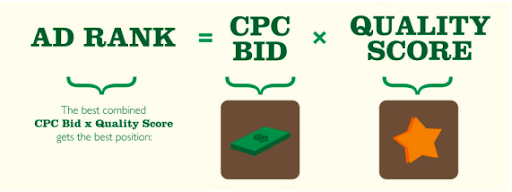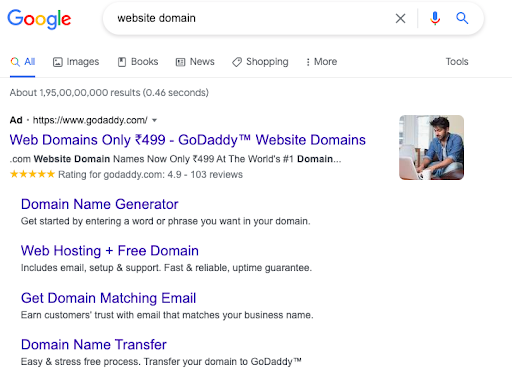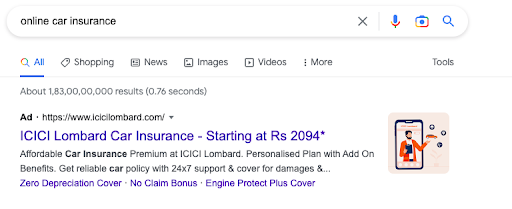Ad Rank
Definition
Ad Rank is a metric that indicates on which search results page the ad is shown relative to other ads.
Description

Google displays your content on top search results when your content qualifies certain standard metrics on Google.
Similarly for ads, Ad Rank is a value that determines where ads will be shown relative to other ads. Ad rank shows how relevant the ad is for the user’s intent.
Ad rank is calculated each time your ad is eligible to appear.
The ad rank is calculated by the bid amount, auction time ad quality, competitiveness of auction, and context of user’s search.
There are three factors to determine the quality of the ad that includes click-through-rate, landing page experience, and ad relevance.
Google takes into account the information provided by the campaign and then puts it into judgement whether the ad is worthy of ranking or not.
Example
Here, when the user searched for a website domain, on the first page showed results for GoDaddy. The ad shows on the top because it will relate to either renewal of the domain or purchase of the domain.

Things to check for higher Ad Ranks
Your ads will be displayed on higher positions in search results if the ad wins the auction. This is how Google decides which ad should it show and where should they be positioned.
To win the auction, this is what marketers should do:
- Set bid right: Set a bid right to tell Google the amount of money you are ready to pay for a click. Consider the amount you want to set considering the expected returns you look at. You can change your bid anytime if you feel the need.
- Check the quality of landing pages and ads: Check how relevant and useful your ads are and to which site the ads link to. Monitor the quality score of the ad and see how you can improve it.
- Ad Rank Threshold: Set a minimum threshold value that the ads must achieve. It will help you compare the ad performance.
- Evaluate the context of the person’s search: You calculate Ad Rank by checking the search terms that people have entered. Also evaluate the relevance of the ad considering the search terms people enter, person’s location at the time of search, what device the users are using, other signals and attributes.
- Add Ad Assets: Create an ad by adding additional information such as phone number, or more links that directs the traffic to your website. With these Ad Assets, Google will identify how each asset will impact the user’s performance.
Actionable Strategies for marketers to improve Ad Rank
These are the actionable strategies that marketers can use to improve Ad Rank:
- Focus on creating better Ads: You can create better ads by understanding the user’s intent. Start by concentrating on a specific buyer persona thinking what solution are they looking for and what are they trying to accomplish.
- Let the ad extensions stand out: Align your extension perfectly with ad campaign goals and calls to action. Google then evaluates the “expected impact of extensions” to find out ad success. Hence, use Ad extensions that match your call-to-action.
- Make the landing page easy to navigate: After reviewing your ads, Google also checks how convenient it is to navigate on the landing page. It also checks whether or not the landing page delivers an exceptional user-experience to the visitors or not. Upgrade the landing page by creating an impactful content copy and design to match the targeted keywords that are used in your ads.
- Create super specific ad groups: Every ad group should have an ad theme and each ad group should focus on a single product or services. You can create and break your ads in 3 groups to include Phrase Match, Exact Match, and Broad Match Modifier.
- Standardise your landing page for each campaign: Standardise landing page content copy for each campaign you create. You can then make small edits to customise the offer in your ad copy.
- Use keywords in the display URL and ad title: If you use keywords in your display url and ad title, it adds to your quality score. It also increases the relevance of your ads to be displayed in the search results.

- Experiment with CTA and offers: Experiment with different call-to-actions and offers that performs the best. Customise the ad copy and run multiple ads within a specific group to see which is the best proposition.
- Optimise your bid strategy: You need to optimise your bid strategy. Increasing bids can impact the acquisition cost in the long run hence, it is better to optimise your bid.
FAQs
What is a good Ad Rank?
Ad Rank is a metric that defines whether the ad is worthy of showing at all. The ad that qualifies for all the benchmarks will be shown on the top. And one that is on the top will have a good Ad Rank.
Is Ad Rank the same as Quality Score?
Quality score is the parameter that is defined by the keywords, landing pages, and ads are evaluated. A campaign can be adjusted according to these parameters only. On the other hand, Ad Rank is Google’s way to decide whether the ad will be shown in the search result or not.
What are the 3 factors that influence the ad rank?
Three factors that influence the ad rank include:
- Expected Clickthrough Rate (CTR)
- Ad Relevance
- The bid amount
How can you increase the ad rank fast without increasing the bids?
These are the some of the ways in which you can increase the Ad rank faster without raising the bids:
- Work on improving quality scores.
- Use search terms as keywords in the advertisement.
- Work on improving the Ad relevance.
- Improve the landing page quality.
- Include main keywords in your ads especially in the Ad Title or URL.
Also Read – Ultimate Facebook Marketing (meta ads) 2024





We would love to have your opinion.